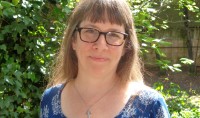The life of faith requires muscle memory
We need to learn to adjust our posture so our theology rings true.

When my daughter took violin lessons as a little girl, I studied her teacher. She would make modest suggestions like, “Move your elbow forward an inch.” My daughter would make this small adjustment and, miraculously, the tone of her violin would deepen. “Bend your thumb, and relax your arm,” the teacher would say, and the bow would sound less raspy on the strings.
I used to wonder: What would this kind of teaching look like in my classroom? What modifications would make the music of theology ring out more clearly in my students’ work and in my own?
As a new school year gets under way, I’ve been thinking again of that violin teacher and her firm, effective adjustments. When a note was flat or sharp, she would sometimes lift up my daughter’s small fingers and press their tips firmly down in the correct place so she would learn what the right note felt like. The teacher was trying to train my daughter’s body to remember how to make a beautiful sound—to develop a muscle memory. She wanted her to be able to make her fingers land on the right note without even having to look.
Read our latest issue or browse back issues.
What kind of muscle memory do we need to cultivate as teachers and students, as theologians and preachers? Some of us reach instinctively for the ancient words of scripture, others for the methods and insights of philosophy, others for the language of poetry and fiction, still others for the rhythms of everyday life. From all of this and more, we fashion our theologies.
This year, in the second semester of the Trump regime, I want to make sure that, in my classroom, we develop muscle memory for history—that we reach for it instinctively, no matter what we are studying. God meets us in history, embodied, incarnate; history is where our life with God unfolds. And the stories we tell about our past have consequences—as we’ve all been reminded in the crash course in history this past summer provided. When the president complained that removing Confederate monuments from public places would “rip apart” our history and culture, he empowered white supremacists. It matters whether we see Confederate monuments as tributes to culture, as the president has asserted, or as monuments to white supremacy, built to reinforce Jim Crow. It matters to our politics, to our common life, and certainly to our theology.
As a white theologian, I feel a particular need to cultivate a muscle memory for history, not only by reading it but by being read by it. Where am I in this history, and what does it ask of me? I want to press down with precision on these questions so that the notes of my theology ring true.
The violin teacher’s instructions for handling the bow always seemed counterintuitive to me—my instinct would be to grasp it firmly so I could get it to do what I wanted it to do. But in fact, a violinist has greater control, and makes a more beautiful sound, if she holds the bow between a bent thumb and a curved hand, looking for all the world like she is balancing the bow lightly between the tips of her fingers.
As a teacher, there are things that I need to practice holding lightly, too: my way of doing things, my way of seeing things, my way of teaching the books that have meant the most to me. I remember a student saying to me once, about Augustine’s Confessions, that “the way you love that book, professor, is making it difficult for me to figure out what I think about it.” I need to learn to hold my bow more lightly and not rush everyone toward a conclusion I worked out long ago.
Beautiful violin music requires a violinist not only to bring her fingers down on the right notes but to use her body to create a rich tone. “You need to move your elbow forward,” my daughter’s teacher often said. She would demonstrate, taking the elbow of the arm holding the violin and turning it just a bit. It was such a graceful gesture, like something you’d see a dancer do, and it had the effect of opening the space around the sound. The notes no longer sounded as if they were being squeezed, one at a time, through a small opening into the world. A slight adjustment gave them room to become something lovely.
How can I help my students and myself open up the space around our theology and give it room to become something more than we have yet imagined? Like a violinist’s elbow, we need to be helped to move forward toward the things we don’t know: the histories we have not yet encountered, the unknowable parts of ourselves and others, the mystery of God, and the spaces in between all of it.
Thomas Merton once wrote that faith does not turn the unknown into the known; it integrates the unknown dynamically into our lives. I want to develop a muscle memory for moving toward what I cannot see, though I feel its claim: that unknowable mystery that sends me back to school each year, hoping to draw a little closer to it, hoping to understand it a little better, in my muscles and in my bones.
A version of this article appears in the September 27 print edition under the title “Theological muscle memory.”







